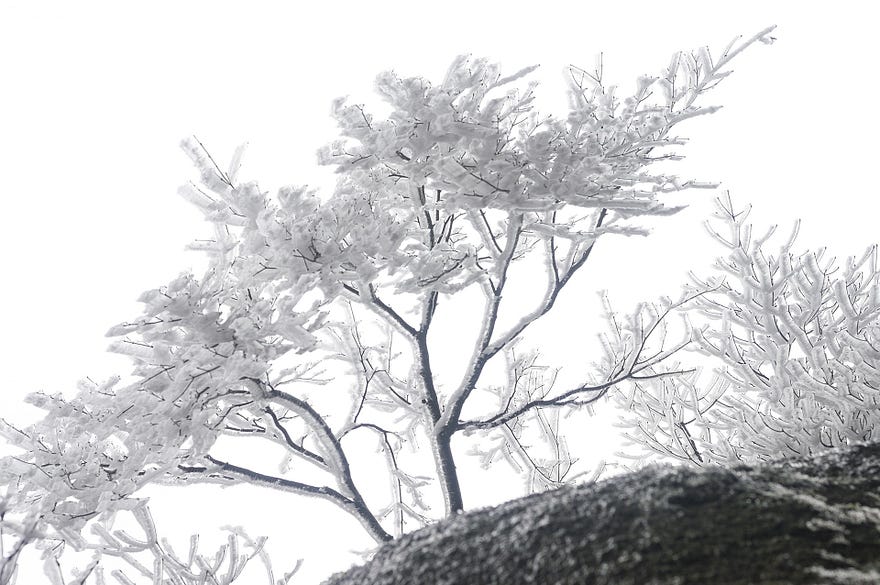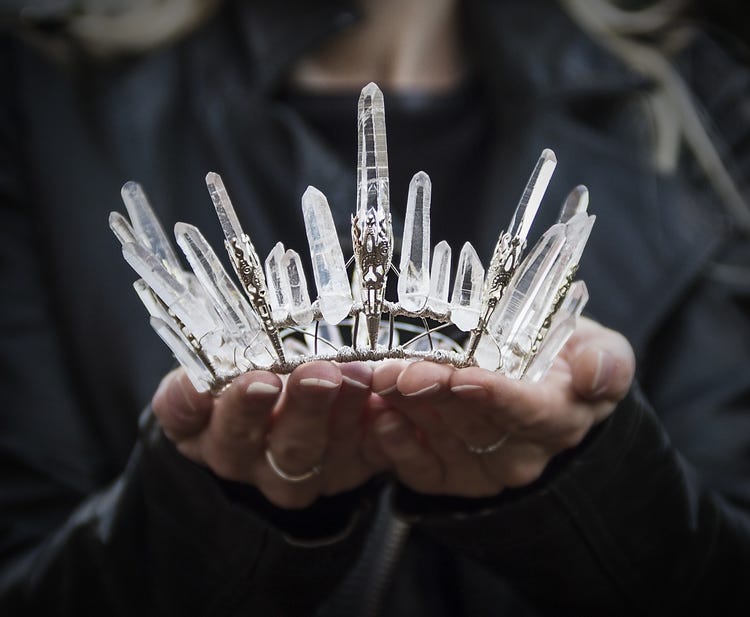Reverse-Engineering Eternity: The Puzzle of the Snow Queen
Content warning for discussion of misogynistic abuse, sexist false dichotomies.
Hans Christian Andersen's The Snow Queen has the distinction of being the one western fairytale that's ever had lasting effect on me — I never did warm to Cinderella, Snow White, Sleeping Beauty, or even the rest of Andersen. Mostly Disney's fault.

There's the exotic world which The Snow Queen presents, the frozen Lappland, the forever winter, the peculiar imagery of the snow bees, that compelled me more than the generic dark forests of Sleeping Beauty or Beauty and the Beast. And part of it was, inevitably, the Snow Queen figure — immaculate, beautiful, limitless. Long before I came to frame all my writing (and I do mean all) through queer lens, she was compelling and magnetic. While a lot of us gravitate to the malicious stepmothers and the evil witch-queens, creating for them a sympathetic perspective or origin story, the Snow Queen has always been ambivalent. Unlike the wicked stepmothers and the witch queens, she's never shown in defeat. Her hold on the boy Kay is a spell done in absentia, an offering of a beautiful puzzle—we never hear from her again past a certain point in the story. In absentia, eternally unattainable, impossible to defeat even by the most pious of Christian girls.
Piecing the Mirror Together
When you rework a western fairytale, you run into the risk of retreading old ground: most have been retold to death or have received the unfortunate Disney treatment or both. The Snow Queen has eluded Disney, but she's been places (and how odd, how interesting, that it is the queen who's usually central rather than Gerda or Kay). Lumi of the Fables comics, Arianrhod of Joan D. Vinge's Snow Queen Cycle, Princess Kaguya of Sailor Moon: Kaguya-hime no Koibito, the White Witch Jadis of The Lion, the Witch and the Wardrobe and Freya from The Huntsman: Winter War (2016). But the source material is still interesting to me, and I wanted to give it a try.
Winterglass isn't an exact retelling. Most keep the core concepts: a boy is corrupted into the worst version of himself, is seduced and taken away by the wintry sorceress-queen, an innocent girl — usually his childhood sweetheart—sets out on an adventure to rescue him and free him from the queen's grasp. That I had to jettison immediately, as I don't find much of interest in a heterosexual love story. The aspect of this story that often plays out as Gerda and the queen vying for control and (sometimes romantic) attention of Kay doesn't interest me either.
Gerda's defining trait, the one that lets her free Kay, is her purity of heart, her innocence, in so many words.
“But can you not give little Gerda something to help her to conquer this power?”
“I can give her no greater power than she has already,” said the woman; “don't you see how strong that is? How men and animals are obliged to serve her, and how well she has got through the world, barefooted as she is. She cannot receive any power from me greater than she now has, which consists in her own purity and innocence of heart. If she cannot herself obtain access to the Snow Queen, and remove the glass fragments from little Kay, we can do nothing to help her. Two miles from here the Snow Queen's garden begins; you can carry the little girl so far, and set her down by the large bush which stands in the snow, covered with red berries. Do not stay gossiping, but come back here as quickly as you can.” Then the Finland woman lifted little Gerda upon the reindeer, and he ran away with her as quickly as he could.
It's a very Christian story (Gerda literally dispels the Snow Queen's enchantments with Christian prayers). The Finnish woman doesn't remark on her endurance or strength: it is Gerda's purity alone that she praises, and Gerda's purity alone that — she asserts—compels and charms all into serving Gerda. Vinge has an interesting take on this, where her Gerda figure Moon Dawntreader does win through kindness and empathy rather than purity, and there's mileage to be had from stories where kindness and empathy are the guiding principles (Steven Universe, Puella Magi Madoka Magica). But so often what happens is that writers position Gerda as the virgin, the queen as the whore, the way it happens in any story where a powerful woman is pitted against a younger, naiver one: just look at Snow White and the Huntsman (2012), Disney's own take on Snow White (1937) or Sleeping Beauty (1950) or The Little Mermaid (1989). Even Vinge's rendition falls into this trap: Arienrhod is defined by her ambition and sexual appetites while her clone Moon is younger, sweeter, kinder and most importantly more innocent (she has sex with one man at a time and only with a deep emotional connection while Snow Queen Arienrhod throws orgies: how scandalous). Sailor Moon plays it straight: an astronomer boy is seduced by the icily beautiful, cruel Kaguya-hime. She is defeated by the titular Sailor Moon, a young woman empowered by her innocence and purity.

So many reinterpretations of the Snow Queen fixate on her having been abused by men into bitterness, even though Andersen's never was— his Snow Queen is a figure of elemental force and alien motivation, untouched by men and untouchable. Freya in The Huntsman: Winter War, Lumi in Fables, one way or another all have been shaped by patriarchal malignancy, by male entitlement. Elsa of Frozen's catalyst is the threat of power-hungry, treacherous men seeking to exploit or remove her. Vinge's Arienrhod is spited one last time by a man— her discarded former lover—as she is thrown into the sea to drown alive. Men, it seems, are inescapable.
This inescapability has something to do, possibly, with the idea that the appeal of The Snow Queen lies in being a story where the girl rescues the boy. While Cinderella, Snow White, and Sleeping Beauty are passive, Gerda adventures. She strives, she endures, and she overcomes. There's certainly something to be said for that, but it's still a girl and a boy. It still confines and, fundamentally, it places supreme importance on the boy as a person so worthy and precious that a flawless, morally impregnable girl beloved by all she comes into contact with will go through hell to regain him. To me this wasn't a fantasy of female empowerment: it is a fantasy of male all-importance.
When I started writing Winterglass with the intent of basing a story on the Andersen, I was faced with a few options.
- Gerda and Kay are both girls, they are lesbians. The Snow Queen is also a woman, older and sexually voracious in contrast to Gerda's and Kay's inexperience.
- Gerda and Kay are both girls, they are lesbians. The Snow Queen is a man, he is a sexual and sexist threat, an embodiment of patriarchal power that suppresses queer women and threatens them with corrective rape.
- Gerda is a boy and Kay is a girl.
And so on, and so on. (Putting them in an American high school or college is, naturally, right out.) Number two goes out the window fast: Andersen's story doesn't have a sexual assault component to it the way Grimm's tend to, and I'm not desperate to introduce any. Making the Snow Queen male would also center a man, and I just don't find that — even when the man is an oppressor — all that interesting; 'darker, more adult' fairytale retellings which play up sexual assault are a well-trodden territory, sometimes to ridiculous excess (take Anne Rice's regrettable The Claiming of Sleeping Beauty).
Another factor is the characters' ages, which is more crucial than you would expect: in the original they start the story as children, and in most retellings they begin their journey as teenagers. I didn't care to write an ingenue who is led by her naivety and who triumphs because of it, or an innocent who falls afoul of icy seduction. I very specifically made Nuawa and Lussadh experienced (in all ways) and accustomed to violence, with Nuawa in her thirties and Lussadh in her forties. Setting next — fairytale retellings are often quite white, with Vinge's The Snow Queen set on a sea planet populated entirely (and improbably) by white Celts. I could set Winterglass in a similar analogue, or a secondary-world mishmash of medieval Europe and Britain, but the Winter Queen's threat seems much more interesting and terrifying as a literalization of colonialism. Sirapirat is not a direct analogue of any one city, but the shape and origins of its culture should be obvious, and I want Nuawa's relationship with her city to be unambiguous: her opinion of Sirapirat would have been very different had she been a person of color born and living in a white-majority country.
I am not actually that enamored of the Andersen story.
It made an impression on me; I felt the images in it were beautiful, more distinct and concrete than anything in Grimm's, more particular. But if pressed I wouldn't, now, name it as something I necessarily love. Andersen provides me with a structure, a few images I like, but I don't owe him or his story any debt. I'm sure I loved it when I was much younger—I looked up every retelling I could find, and was incredibly into Vinge's version—but it's not just that Andersen's story is deeply white, I also don't believe in what it believes: that resistance through innocence suffices or even works. The Gerdas of the world, in their white purity, may be able to get what they want through demonstrating that they have beautiful hearts and sterling character. But for people like Nuawa, women of color subjugated by imperialism, that will not get us very far at all. We know that we're born screaming, and to our graves we'll be screaming still, fighting to breathe and to die with dignity. Prayer is for white girls whose innocence will be believed, whose goodness is assumed and whose socialized position is ever on pedestals.
Vinge's Moon Dawntreader is chosen by the closest thing to a god and taught from childhood to be kind and loving, because in both her world and ours, the compassionate heart of a white girl is an assumption supported by universal consensus. Andersen's Gerda dispels the Snow Queen by Christian prayer; animals love her, people cannot resist helping her, and to the end she and Kay remain 'children at heart', pure and therefore fit for God's light. Nuawa survives to adulthood on a terrible sacrifice, raised and forged to be a weapon who will burn her heart out if it means overthrowing a tyrant.
And this, to me, is what it means to reconfigure a fairytale through post-colonialist lens: not just by making the characters of color rather than white, but by upsetting completely the worldview and assumptions of the white original. It is to relocate everything from the pale, frozen lands of Europe to a country all your own, and it is about — most of all — fighting with everything you have, even if it becomes your undoing, because you know no alternative exists and no gentler options will be offered.
Winterglass is a lesbian epic fantasy based on 'The Snow Queen', set in secondary-world Southeast Asia, out December 2017, and available now for pre-order.



0 comments:
Post a Comment